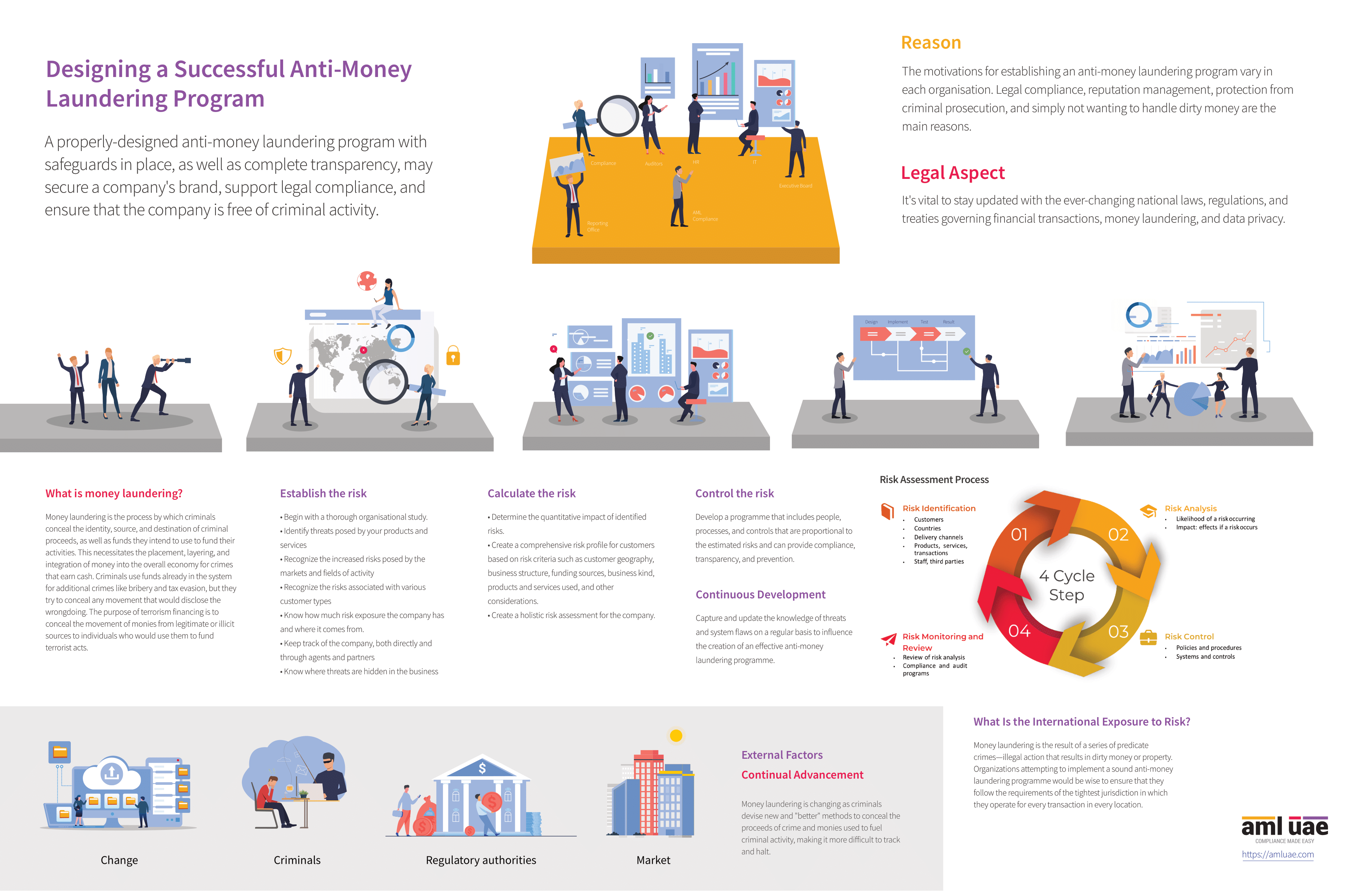The risk based approach to AML - Anti-Money Laundering Compliance
The risk-based approach (RBA) is basically the realization of control in Anti-
money Laundering management according to the risk appetite of the business enterprises, risk perception, and the risk level of the customers. Every business has its own risk-bearing capacity, and in Anti-money Laundering compliance, it becomes essential to adopt a risk-based approach in order to take calculated moves.
Under a RBA, there is no such thing as ZERO risk.
This article is going to talk about the importance of a risk-based approach in AML compliance. So without wasting much of your time, let us begin.
What is risk-based approach in Anti-Money Laundering (AML)?
The risk-based approach (RBA) helps reporting entities effectively identify, assess and tackle ML/TF/PF risks.
Financial Institutions, Designated Non-Financial Businesses and Professions, and Virtual Asset Service Providers should apply appropriate measures and procedures commensurate with the risks of money laundering, terrorist financing, and proliferation financing.
The risk-based approach enables the reporting entities to apply their efforts optimally to mitigate ML/TF/PF and sanctions risks. The RBA provides the risk-sensitive application of AML/CFT measures. Accordingly, companies are able to apply the principle of “higher the risks, higher the controls”.
The application of the risk-based approach helps firms decide on the degree, frequency, or intensity of the ML/TF/PF/ controls.
Step-by-step implementation of Risk-Based Approach
- Identify and assess ML/TF/PF risks
- Document policies, procedures, and controls to mitigate the identified risks
- Implement policies, procedures, and controls to manage and mitigate the identified risks
- Monitor the results and make necessary changes to tackle the ML/TF/PF risks better
Principles of The Risk Based Approach to AML Compliance
Acceptance of the existence of risk is the first thing that actually matters when it comes to the principles of the Risk Based Approach to AML. A risk assessment should be carried out according to the intensity of risk, and the risk assessment process should be examined, and the compliance process should be applied.
Inherent Risk: The gross risk assessed by the reporting entity before putting any AML/CFT controls and measures in place
Residual Risk: The residual risk is the risk the reporting entity assesses once AML/CFT controls and measures are in place.
According to the principles of a risk-based approach, the same process of Know Your Customer (KYC) should not be applied to customers who carry
either a high-risk profile or a medium-risk profile. Hence, it is viable only for customers with negligible or low-risk quotient.
For instance, the Customer Due Diligence (CDD) Process for Politically Exposed People (PEPs), which undoubtedly belongs to a high-risk profile, is insufficient. Therefore, the help of Enhanced Due Diligence or EDD procedures might be required for this.

Practically implementing all these compliance policies might seem complicated, but with the help of artificial intelligence-supported anti-money laundering software solutions, the facilitation of AML compatibility is possible.
Importance of Risk-Based Approach in Anti-Money Laundering Compliance
Besides that, the risk-bearing appetite of the companies from the same industry also differs because the anti-money laundering laws and economic structure of the countries are not the same.
Here is when the need and importance of a risk-based approach come into the picture. With the help of a risk-based approach, companies from various countries can create an anti-money laundering program that is universally suitable and effectively minimizes their risk.
Compliance. Trust. Transparancy
Customized and cost-effective AML compliance services to support your business always
Primary Elements of a Risk-Based Approach in AML Compliance
1- Anti-money Laundering Transaction Monitoring

Considering the big business enterprises mediate multiple transactions in a single day, performing all these controls manually will waste a lot of your time and efforts.
2- Know Your Customer or Customer Due Diligence (CDD)
Knowing your customer and the customer due diligence process are carried out in order to identify who your customers really are and also to verify their identity and work.
These procedures are one of the most fundamental building blocks of efficient and effective anti-money laundering compliance management.
Within the scope of these procedures, you can determine your first relationship with the customer and afterward take necessary actions in order to mitigate those probable risks.

Compliance. Trust. Transparancy
Customized and cost-effective AML compliance services to support your business always

3- AML Compliance Officer
The primary role of an anti-money laundering compliance officer in business enterprises is very important.
An AML compliance officer identifies threats related to anti-money
laundering threats and also has the authority to report suspicious cases to the concerned authorities.
Thus, an AML compliance officer is an integral part of the implementation of the risk-based approach.
4- Adverse Media Screening
Plus, keeping an eye on such news is the best way to protect your organization from any potential risks that might come into the picture upon dealing with clients with high-risk profiles.

How Does the Risk-Based Approach Work in AML?
-
Build and develop suitable customer due diligence (CDD) and know your customer (KYC) measures to verify the authenticity and legitimacy of the business they are involved with.
CDD and KYC are the foundational principles of the risk-based approach of anti-money laundering compliance.
More information might be required for people who belong to a high- risk category and might also require enhanced due diligence or EDD. - Screening of new and existing customers against the international and domestic sanctioned lists.
- Screening the new and the existing customers against the politically exposed personnel (PEPs) list. When the political status of an individual changes, the risk of money laundering also changes.
- Screening the new and the existing customers against the adverse media. This becomes crucial if your customer is subject to negative news or a part of the group that was accused of manipulative activities.
- Appoint a dedicated AML compliance officer. An AML compliance officer has sufficient authority to identify any activity directly or indirectly signals to money laundering threats.
Final words
The UAE AML CFT Law requires FIs, DNFBPs, and VASPs to employ a risk-based approach that is tailored to their business. The controls employed by a reporting entity should be in sync with the risks it is exposed to. Money Laundering and Terrorist Financing risks differ from organization to organization and industry to industry. Therefore, DNFBPs need to assess and understand ML/TF risks associated with each customer, supplier, and third party.
The adoption of a risk-based approach does not mean that the organization will be able to eliminate all risks related to financial crime. It only means that ML/TF risks are managed but the organization is still vulnerable to various risks that it couldn’t identify and assess. As risks, by their very nature, are dynamic.
With this, we now understand what social and economic impact money laundering has on the economy of the country and how to overcome or reduce the adverse effects of the same on the economy. For this,AML UAE can help, as an expert, in better implementation of AML/CFT policies in one's organization and contribute towards minimizing the negative socio-economic impact of money laundering activities.
Our recent blogs
side bar form
Share via :
FAQs - Importance of a Risk-based Approach
Here are a few frequently asked questions when it comes to establishing the importance of a risk-based approach in AML compliance.
A basic Know Your Customer (KYC) procedure is enough for a low-risk customer. For a medium risk client, the entity must conduct Customer Due Diligence (CDD). If the client is a PEP, terrorist, or features in any government Sanction lists, Enhanced Due Diligence (EDD) becomes essential.
To monitor your transactions, you can apply a risk-based approach to them. For that, entities can create risk-based rules and scenarios to bifurcate transactions into different risk categories. Sudden rise in transactions, transactions with PEPs or Sanctioned individuals, or questionable transaction jurisdiction are some risk scenarios.
The steps of the risk-based approach are:
- Identify the potential risks to your business
- Determine the intensity level of each
- Assess the probability of the risk event happening
- Plan the corrective actions
- Implement and modify
The primary benefits of risk-based approaches are:
- They are proactive and not reactive. That means you prepare for threats before the threats affect your business.
- You have the flexibility to adapt to the changes
- You implement action plans suited to the type of risks, which improves the value for businesses
However, throughout the process, if you experience any unusual activity, you can ask the client or potential client to provide additional information about certain things along with legal documents to support that claim.
If the concerned individual is able to provide all the proof, he or she is out of the woods. But, if they fail to, this is when it gets crystal clear that something unethical or illegal is happening, and you file STRs.
With this said, Financial Institutions and DNFBPs should naturally integrate risk control mechanisms and ideas in the development and management of business.
DNFBPs and DPMS are required to build strict and rigid AML compliance principles, enforce the entire process, and unified risk management mechanisms to establish a compliant and sound management culture within the operational and functional areas of the business.
In addition to that, an AML compliance officer is also responsible for screening & monitoring, prevention of payment frauds, and transaction monitoring for cryptocurrency and fiat.
Besides this, an AML compliance officer is responsible for performing the following functions.
- Assisting in the implementation of an AML program within the scope of the organization
- Arranging inspections or interrogations from a third-party organization and eliminating all the potential mistakes
- Looking after the records of high-risk clients and report all the suspicious activities without wasting any time
Add a comment
About the Author
Pathik Shah
FCA, CAMS, CISA, CS, DISA (ICAI), FAFP (ICAI)
Pathik is a Chartered Accountant with more than 25 years of experience in compliance management, Anti-Money Laundering, tax consultancy, risk management, accounting, system audits, IT consultancy, and digital marketing.
He has extensive knowledge of local and international Anti-Money Laundering rules and regulations. He helps companies with end-to-end AML compliance services, from understanding the AML business-specific risk to implementing the robust AML Compliance framework.





